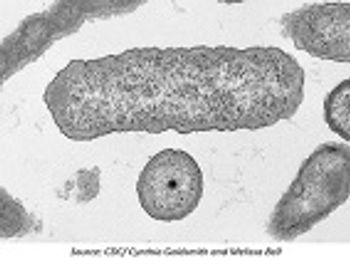
New research finds that RNA expression may be the key to diagnosing bacterial infections in infants.

New research finds that RNA expression may be the key to diagnosing bacterial infections in infants.

An initiative from the Veterans Health Administration to reduce methicillin resistant Staphylococcus aureus (MRSA) and other healthcare-associated infections in the facilities has led to marked infection reduction around the country.

In a phase 3 clinical trial, Japanese patients with chronic hepatitis C (HCV) infection without liver cirrhosis were able to achieve high sustained viral response rates after taking an investigational HCV drug from AbbVie.

In response to the increasing number of syphilis cases reported in Japan, the Japanese government is launching a prevention campaign that will include Sailor Moon as a spokesperson for sexual education.

A new biotechnology company, Vir Biotechnology, is gunning for bear in the fight against infectious diseases and boasting a roster of heavy hitters in the industry.

These findings discredit previous allegations that this outbreak was the cause of one source and that the number of cases is higher than that identified in previous years.

The 2016-2017 influenza season continues to see a growing number of severe flu cases due to the increased prevalence of influenza A (H3N2) virus.

Researchers from the University of Bristol have revealed the structural and mechanistic basis of transferable colistin resistance conferred by the MCR-1 gene.

Researchers at Southern Research Institute are focusing their efforts on finding a broad-spectrum antiviral drug that will be effective against a number of influenza strains.

A new genital herpes drug, pritelivir, has demonstrated greater virus suppression than the present standard treatment in a clinical trial.

Researchers from Martinique, France have determined that current tools to diagnose Chikungunya infection in older adults may not be useful.

The H3N2 strain of influenza continues to circulate throughout Calgary, as well as in the South Zone, while “little influenza activity in the North Zone [has been observed] to date.”

Elizabeth Nolan, PhD, and her team at the Massachusetts Institute of Technology, recently explored the fight between microbes and hosts over essential metals and how understanding this battle may open the door for alternate treatments for bacterial infections.

A new study has provided more evidence to show that certain heartburn medications may make individuals more susceptible to gastrointestinal infections.

Researchers have found no link between an influenza infection during pregnancy and an increased risk of an autism spectrum disorder diagnosis.

Researchers have conducted a study looking into the role that vitamin D might play in reducing the number of acute respiratory infections that are experienced by older adults residing in long-term care facilities.

University of Connecticut researchers have developed novel antibiotic compounds to target methicillin-resistant Staphylococcus aureus infections, offering a potential new drug in the fight against this pathogen.

Undocumented immigrants face particular difficulties accessing primary medical care in the US.

Dutch scientists have identified the best conditions for Legionella growth: conditions that support biofilm growth.

A new report finds that real-time patient-centered research is possible during an outbreak, and indeed, necessary to strengthen systems, improve surveillance and response, and create better diagnostics, therapeutics and vaccines.

Researchers have found potential evidence that suggests Ebola may be able to replicate in the lungs of recovering patients.

As adults are living longer, they are able to continue to have healthy sex lives. Unfortunately, many are not practicing safe sex, and healthcare practitioners are not screening their older patients for sexually transmitted diseases (STDs).

Researchers uncover high rates of co-infections in patients who are admitted to hospitals with influenza.

A research team examines two Yosemite plague diagnoses to determine effectiveness of procedures for the detection, protection, and prevention of Yersinia pestis.

Researchers have found that anemia offers protection against malaria in African children and that iron supplements may actually reverse this protective effect.

Seeking to improve the nation’s health and safety, the Centers for Disease Control and Prevention (CDC) has been targeting several high-burden issues in which it could make the greatest impact, and three such issues are infectious diseases.

Following superbug outbreaks around the world linked to contaminated endoscopic devices, the US Food and Drug Administration (FDA) has approved two new one-time use endoscopes.

A team of researchers has found that individuals with weakened immune systems are the most at risk of infection by listeriosis contamination in food products.

Sustaining a burn that lands a patient in the hospital may have long-term implications for their risk of acquiring infectious diseases later on.

A team from Duke University’s Developing World Healthcare Technologies Lab have discovered a way to extend the lifespan of antiretroviral drugs in order to prevent mother-to-child HIV transmission in developing countries.